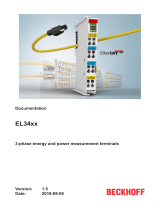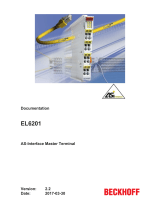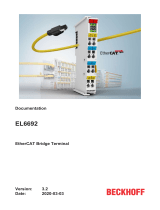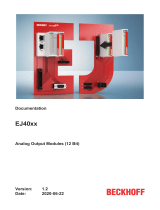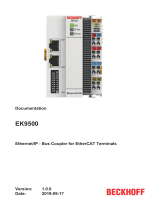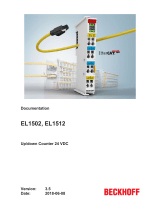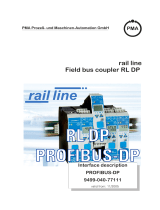Page is loading ...

Documentation
EK3100
PROFIBUS Bus Coupler for EtherCAT Terminals
1.5
2020-04-23
Version:
Date:


Table of contents
EK3100 3Version: 1.5
Table of contents
1 Foreword ....................................................................................................................................................5
1.1 Notes on the documentation..............................................................................................................5
1.2 Safety instructions .............................................................................................................................6
1.3 Documentation issue status ..............................................................................................................7
2 Product overview.......................................................................................................................................8
2.1 EKxxxx - System overview ................................................................................................................8
2.2 EK3100 - Introduction........................................................................................................................9
2.3 Technical data - EK3100 .................................................................................................................10
2.4 Technical data - PROFIBUS............................................................................................................11
3 Mounting and wiring................................................................................................................................12
3.1 Instructions for ESD protection........................................................................................................12
3.2 Mounting..........................................................................................................................................12
3.2.1 Dimensions ...................................................................................................................... 12
3.2.2 Installation on mounting rails – Bus Coupler ................................................................... 13
3.3 Wiring...............................................................................................................................................16
3.3.1 Power supply ................................................................................................................... 16
3.3.2 PROFIBUS interface (X001)............................................................................................ 17
3.3.3 Cabling............................................................................................................................. 18
3.3.4 Topology .......................................................................................................................... 20
3.4 UL notice .........................................................................................................................................21
3.5 ATEX - Special conditions (standard temperature range) ...............................................................22
3.6 ATEX - Special conditions (extended temperature range) ..............................................................23
3.7 Continuative documentation about explosion protection .................................................................24
3.8 Version identification of EtherCAT devices .....................................................................................24
3.8.1 Beckhoff Identification Code (BIC)................................................................................... 28
4 Parameterization and Commissioning ..................................................................................................30
4.1 USB interface ..................................................................................................................................30
4.2 Address selection switch .................................................................................................................30
4.3 2-pin DIP switch...............................................................................................................................31
4.4 IP address (via USB interface) ........................................................................................................31
5 Configuration ...........................................................................................................................................32
5.1 EtherCAT configurations .................................................................................................................32
5.2 Beckhoff Device Manager ...............................................................................................................36
5.2.1 Installing the USB driver .................................................................................................. 36
5.2.2 Starting the Beckhoff Device Manager ............................................................................ 38
5.2.3 Setting the mappings for EtherCAT Terminals ................................................................ 39
5.2.4 Configuring EtherCAT Terminals .................................................................................... 41
5.2.5 Using Restore file ............................................................................................................ 42
5.3 Configuration in TwinCAT 3.............................................................................................................43
5.3.1 Adding the EK3100 Bus Coupler in TwinCAT ................................................................. 43
5.3.2 Using the CtrlStatus DWORD.......................................................................................... 44
5.3.3 Adding an EtherCAT Terminal......................................................................................... 45
5.3.4 Creating a virtual slave .................................................................................................... 46

Table of contents
EK31004 Version: 1.5
5.3.5 Packing digital signals ..................................................................................................... 48
5.4 Accessing COE data with DPV1 services .......................................................................................49
5.4.1 Activating the DPV1 service ............................................................................................ 49
5.4.2 Note the structure of the DPV1 telegram ........................................................................ 51
6 Error handling and diagnostics..............................................................................................................52
6.1 Diagnostic LEDs ..............................................................................................................................52
6.2 Power supply terminal LEDs in K-bus mode ...................................................................................52
6.3 Diagnostics via PROFIBUS .............................................................................................................53
6.3.1 Diagnostics for virtual slaves ........................................................................................... 53
6.3.2 Configuration of the diagnostic telegram ......................................................................... 54
7 Appendix ..................................................................................................................................................55
7.1 Update Bus Coupler image .............................................................................................................55
7.2 Support and Service ........................................................................................................................56
List of tables.............................................................................................................................................57
List of illustations....................................................................................................................................58

Foreword
EK3100 5Version: 1.5
1 Foreword
1.1 Notes on the documentation
Intended audience
This description is only intended for the use of trained specialists in control and automation engineering who
are familiar with the applicable national standards.
It is essential that the documentation and the following notes and explanations are followed when installing
and commissioning these components.
It is the duty of the technical personnel to use the documentation published at the respective time of each
installation and commissioning.
The responsible staff must ensure that the application or use of the products described satisfy all the
requirements for safety, including all the relevant laws, regulations, guidelines and standards.
Disclaimer
The documentation has been prepared with care. The products described are, however, constantly under
development.
We reserve the right to revise and change the documentation at any time and without prior announcement.
No claims for the modification of products that have already been supplied may be made on the basis of the
data, diagrams and descriptions in this documentation.
Trademarks
Beckhoff
®
, TwinCAT
®
, EtherCAT
®
, EtherCATG
®
, EtherCATG10
®
, EtherCATP
®
, SafetyoverEtherCAT
®
,
TwinSAFE
®
, XFC
®
, XTS
®
and XPlanar
®
are registered trademarks of and licensed by Beckhoff Automation
GmbH. Other designations used in this publication may be trademarks whose use by third parties for their
own purposes could violate the rights of the owners.
Patent Pending
The EtherCAT Technology is covered, including but not limited to the following patent applications and
patents: EP1590927, EP1789857, EP1456722, EP2137893, DE102015105702 with corresponding
applications or registrations in various other countries.
EtherCAT
®
is registered trademark and patented technology, licensed by Beckhoff Automation GmbH,
Germany.
Copyright
© Beckhoff Automation GmbH & Co. KG, Germany.
The reproduction, distribution and utilization of this document as well as the communication of its contents to
others without express authorization are prohibited.
Offenders will be held liable for the payment of damages. All rights reserved in the event of the grant of a
patent, utility model or design.

Foreword
EK31006 Version: 1.5
1.2 Safety instructions
Safety regulations
Please note the following safety instructions and explanations!
Product-specific safety instructions can be found on following pages or in the areas mounting, wiring,
commissioning etc.
Exclusion of liability
All the components are supplied in particular hardware and software configurations appropriate for the
application. Modifications to hardware or software configurations other than those described in the
documentation are not permitted, and nullify the liability of Beckhoff Automation GmbH & Co. KG.
Personnel qualification
This description is only intended for trained specialists in control, automation and drive engineering who are
familiar with the applicable national standards.
Description of instructions
In this documentation the following instructions are used.
These instructions must be read carefully and followed without fail!
DANGER
Serious risk of injury!
Failure to follow this safety instruction directly endangers the life and health of persons.
WARNING
Risk of injury!
Failure to follow this safety instruction endangers the life and health of persons.
CAUTION
Personal injuries!
Failure to follow this safety instruction can lead to injuries to persons.
NOTE
Damage to environment/equipment or data loss
Failure to follow this instruction can lead to environmental damage, equipment damage or data loss.
Tip or pointer
This symbol indicates information that contributes to better understanding.

Foreword
EK3100 7Version: 1.5
1.3 Documentation issue status
Version Modifications
1.5 • Update chapter “Technical data”
1.4 • Update chapter “Configuration”
1.3 • Update chapter UL notice
1.2 • Update chapter “Update Bus Coupler image”
1.1 • Minor corrections & addenda
1.0 • First version and publication

Product overview
EK31008 Version: 1.5
2 Product overview
2.1 EKxxxx - System overview
Fig.1: EtherCAT Terminals at an EKxxxx series Bus Coupler
The Bus Couplers from the EKxxxx series allow EtherCAT Terminals to be operated on conventional fieldbus
systems. The ultra-fast, high-performance EtherCAT Terminals with their large range of signal types are thus
also available for other fieldbus and Industrial Ethernet systems.
The EKxxxx Bus Couplers are fieldbus slaves and contain an EtherCAT master for the EtherCAT terminals.
They convert the telegrams from the higher-level fieldbus systems into the E-bus signal representation. A
station consists of an EKxxxx and a number of EtherCAT Terminals.
The EKxxxx is integrated in exactly the same way as the Bus Couplers from the BKxxxx series via the
corresponding fieldbus system configuration tools and the associated configuration files, such as GSD, ESD
or GSDML.
EtherCAT makes a very flexible topology configuration possible. Thanks to the Ethernet physics, long
distances can also be bridged without the bus speed being affected. When changing to the field level –
without a control cabinet – the EtherCAT Box modules (EPxxxx) in protection class IP65 can also be
connected to the EK9xxx.
Bus Couplers for various fieldbus systems
The variants from the EKxxxx series differ from one another by the interface for the higher-level fieldbus
system.
An overview of the various Beckhoff Bus Couplers covering the most important fieldbus systems can be
found on the Beckhoff Website.
Embedded PCs with fieldbus interface and decentralized control
The TwinCAT-programmable variant is the CX80xx Embedded PC series.
The variants from the CX80xx series differ from one another by the interface for the higher-level fieldbus
system and the possibility to program it.
An overview of the various Beckhoff Embedded PCs covering the most important fieldbus systems can be
found on the Beckhoff Website.

Product overview
EK3100 9Version: 1.5
2.2 EK3100 - Introduction
Fig.2: EK3100 product overview.
The EK3100 Bus Coupler connects PROFIBUS networks with the EtherCAT Terminals (ELxxxx) and
EtherCAT Box modules (EPxxxx) and converts the telegrams from PROFIBUS to E-bus signal
representation.
One station consists of an EK3100 and any number of EtherCAT Terminals. A 9-pin D-sub connector is used
for connecting the coupler to PROFIBUS. In EtherCAT, the PROFIBUS coupler has at its disposal a lower-
level, powerful and ultra-fast I/O system with a large selection of terminals. The coupler supports the
PROFIBUS profile and therefore fits seamlessly into PROFIBUS networks.
Configuration
The EK3100 is configured via HTML pages provided by the Bus Coupler (Beckhoff device manager) or via
the PROFIBUS DPV1 services.

Product overview
EK310010 Version: 1.5
2.3 Technical data - EK3100
Technical data EK3100
Bus interface 1 x D-sub socket, 9-pin with shielding
Protocol PROFIBUS DP
Data transfer rates up to max. 12 Mbaud (automatic recognition)
Interfaces 1 x USB (behind the front flap)
Web interface yes
Power supply 24 V DC (-15 %/+20 %)
Power contacts 24 V DC max./10 A max.
Electrical isolation 500 V (power contact/supply voltage)
Max. power loss 3W
I/O connection E-bus (EtherCAT Terminals)
Power supply for I/O terminals max. 2A
I/O terminals E-bus (EL, ES, EP), standard digital signals, standard analog signals. All
compatible EtherCAT devices are listed in the GSD file.
No gateway EC terminals, no EC terminals with XFC or DC function.
Number of EtherCAT devices max. 255
Dimensions (W x H x L) 65mm x 100mm x 73mm
Operating/storage temperature
horizontal mounting position
-25°C … +60°C/-40°C … +85°C
Operating/storage temperature
other mounting position
0…+55 °C/-25…+85 °C
Relative humidity 95% no condensation
Vibration/shock resistance Conforms to EN60068-2-6/EN 60068-2-27
EMC immunity/emission Conforms to EN61000-6-2/EN 61000-6-4
Protect. class / installation pos. IP 20/variable
Approvals CE,
cULus
ATEX [}22]

Product overview
EK3100 11Version: 1.5
2.4 Technical data - PROFIBUS
Technical data PROFIBUS (EK3100)
Number of I/O modules depending on controller
Number of I/O points depending on controller
Data transfer medium shielded copper cable, 2 x 0.25 mm²
Cable length 1200m 1000m 400m 200m 100m
Data transfer rate 9.6/19.2/93.75
kbaud
187.5 kbaud 500 kbaud 1500 kbaud 3 /6 /12
Mbaud
Topology Line topology
Fieldbus PROFIBUS DP
Bus interface 1 x D sub-socket, 9-pin
Extendable process image Up to 3 virtual slaves in addition
max. process image 4 slaves x (240 bytes in / 240 bytes out)
Protocol
PROFIBUS DP slave Yes
PROFIBUS-DP (virtual slave) 4 (3 virtual PROFIBUS nodes)
Functions/Services
PROFIBUS DP
DPV1 class 1 Yes
Diagnostics/Status/Alarm
RUN LED Yes, green/red
BF LED Yes, green/red
DIA LED Yes, green/red

Mounting and wiring
EK310012 Version: 1.5
3 Mounting and wiring
3.1 Instructions for ESD protection
NOTE
Destruction of the devices by electrostatic discharge possible!
The devices contain components at risk from electrostatic discharge caused by improper handling.
• Please ensure you are electrostatically discharged and avoid touching the contacts of the device directly.
• Avoid contact with highly insulating materials (synthetic fibers, plastic film etc.).
• Surroundings (working place, packaging and personnel) should by grounded probably, when handling
with the devices.
• Each assembly must be terminated at the right hand end with an EL9011 or EL9012 bus end cap, to en-
sure the protection class and ESD protection.
Fig.3: Spring contacts of the Beckhoff I/O components
3.2 Mounting
3.2.1 Dimensions
The following illustrations show the dimensions of the Bus Couplers.
Drawings in DWF and STEP format can be found in the Download section of the Beckhoff website.

Mounting and wiring
EK3100 13Version: 1.5
Fig.4: Dimensions, based on EK9300 as an example.
3.2.2 Installation on mounting rails – Bus Coupler
Snapping onto the mounting rail
The Bus Coupler can simply be snapped onto the mounting rail. To this end position the block on the
mounting rail and push it slightly until it engages on the right-hand side. This is indicated by a distinct click.
Use a screwdriver to push up the lock on the left-hand side, thereby turning it and causing it to engage
audibly.
Fig.5: Snapping onto the mounting rail, based on the EK9300 as an example.
NOTE
Avoid damage!
Do not force the module or apply excessive pressure!
Installation positions
The installation position of the Bus Coupler is arbitrary.

Mounting and wiring
EK310014 Version: 1.5
NOTE
Installation position of EtherCAT terminals
Observe the installation position of the EtherCAT terminals used – not all of them have an arbitrary installa-
tion position. Pay attention to the respective EtherCAT infrastructure components and installation instruc-
tions.
Fig.6: Recommended distances for standard installation position, based on the EK9300 as an example.
NOTE
Comply with the permitted installation position and minimum distances!
We recommend the installation in the horizontal position for optimum ventilation. Furthermore, it is not nec-
essary with this installation position to check whether there are terminals present that may only be installed
horizontally.
Other installation positions are allowed, but not recommended.

Mounting and wiring
EK3100 15Version: 1.5
Fig.7: Other installation positions, based on the EK9300 as an example.

Mounting and wiring
EK310016 Version: 1.5
3.3 Wiring
3.3.1 Power supply
Supply of Bus Couplers and Bus Terminals (Us)
The Bus Coupler requires a supply voltage of 24V
DC
(-15 %/+20 %) for operation.
The connection is made via the two upper terminal points labelled 24V and 0V. This power input supplies
the Bus Coupler electronics and, via the E-Bus, the electronics of the EtherCAT Terminals. It is electrically
isolated from the peripheral supply (Up) of the power contacts.
In order to guarantee the operation of the Bus Coupler and the terminal segment in all cases, the power
supply unit must supply 2A at 24V.
Fig.8: Bus Coupler power supply, based on the EK9300 as an example.
Power contacts supply (Up)
The three power contacts (spring contacts) are located on the right-hand lateral surface of the Bus Coupler.
The spring contacts are hidden in slots so that they can not be accidentally touched. When a Bus Terminal is
added, its blade contacts are connected to the spring contacts of the Bus Coupler. The tongue and groove
guides on the top and bottom of the Bus Terminal Controllers and of the Bus Terminals guarantees that the
power contacts mate securely.
The lower six terminal points labelled +, - and PE are for supplying power to the peripheral supply (Up).
These terminal points are connected in pairs to a power contact. This power input allows voltages of up to 24
V and is electrically isolated from the Bus Coupler supply voltage (Us).
The connection of these terminal points in pairs enables the supply to be forwarded. The current load of the
power contacts may not permanently exceed 10 A. The current carrying capacity between two terminal
points is identical to the current carrying capacity of the connecting wires.
The spring-loaded terminal points are designed for wires with cross-sections from 0.08mm² to 2.5mm².

Mounting and wiring
EK3100 17Version: 1.5
LED
If the power supply unit is connected correctly and the power supply is switched on, the two upper LEDs in
the terminal prism are green. The left-hand LED (Us) indicates the supply for the Bus Coupler electronics.
The right-hand LED (Up) indicates the supply for the power contacts. The other LEDs indicate the state of
the E-bus. The detailed meanings of the LED displays are described in the chapter LED displays.
PE power contacts
NOTE
Power contact PE
The PE power contact must not be used for other potentials.
3.3.2 PROFIBUS interface (X001)
PROFIBUS, 9-pin D-sub
Pin 6 transfers 5V
DC,
pin 5 transfers GND for the active termination resistor. These must never be used for
other functions, as this can lead to destruction of the device.
Pins 3 and 8 transfer the PROFIBUS signals. These must never be swapped over, as this will prevent
communication.
Fig.9: PROFIBUS, Pin assignment D-Sub
The Profibus bus line is connected via a 9-pin D sub with the following pin assignment:
Pin Assignment
1 Shielding
2 not used
3 RxD/TxD-P
4 not used
5 GND
6 +5 V
DC
7 not used
8 RxD/TxD-N
9 not used
cable colors
PROFIBUS line D sub
B red Pin 3
A green Pin 8

Mounting and wiring
EK310018 Version: 1.5
3.3.3 Cabling
Physical aspects of the data transmission are defined in the PROFIBUS standard (see PROFIBUS layer 1:
Physical Layer).
The types of area where a fieldbus system can be used is largely determined by the choice of the
transmission medium and the physical bus interface. In addition to the requirements for transmission
security, the expense and work involved in acquiring and installing the bus cable is of crucial significance.
The PROFIBUS standard therefore allows for a variety of implementations of the transmission technology
while retaining a uniform bus protocol.
Cable-based transmission:
This version, which accords with the American EIA RS-485 standard, was specified as a basic version for
applications in production engineering, building management and drive technology. A twisted copper cable
with one pair of conductors is used. Depending on the intended application area (EMC aspects should be
considered) the shielding may be omitted.
Two types of conductor are available, with differing maximum conductor lengths (see the RS485 table).
RS-485 transmission according to the PROFIBUS standard
Network topology Linear bus, active bus terminator at both ends, stubs
are possible.
Medium Shielded twisted cable, shielding may be omitted,
depending upon the environmental conditions (EMC).
Number of stations 32 stations in each segment with no repeater. Can be
extended to 125 stations with repeater
Max. bus length without repeater 100 m at 12 Mbit/s
200 m at 1500 Kbit/s, up to 1.2 km at 93.75 kbit/s
Max. bus length with repeater Repeaters can increase the bus length up to 10km.
The number of repeaters possible is at least 3, and,
depending on the manufacturer, may be up to 10.
Data transfer rate (adjustable in steps) 9.6kbit/s; 19.2kbit/s; 93.75kbit/s; 187.5kbit/s;
500kbit/s; 1500kbit/s; 12Mbit/s
Connector 9-pin D sub connector for IP20
M12 round connector for IP65/67
Cable-related faults
Note the special requirements on the data cable for bit rates greater than 1.5 Mbit/s. The correct cable is a
basic requirement for correct operation of the bus system. If a simple 1.5 Mbit/s cable is used, reflections
and excessive attenuation can lead to some surprising phenomena. It is possible, for instance, for a
connected PROFIBUS station not to achieve a connection, but for it to be included again when the
neighboring station is disconnected. Or there may be transmission errors when a specific bit pattern is
transmitted. The result of this can be that when the equipment is not operating, PROFIBUS works without
faults, but that there are apparently random bus errors after start-up. Reducing the bit rate (<93.75kbit/s)
corrects this faulty behavior.
If reducing the bit rate does not correct the error, then in many cases this can indicate a wiring fault. The two
data lines may be crossed over at one or more connectors, or the termination resistors may not be active, or
they may be active at the wrong locations.
Preassembled cable from BECKHOFF
Installation is made a great deal more straightforward if preassembled cables from BECKHOFF are
used! Wiring faults are avoided, and commissioning is more rapidly completed. The BECKHOFF
range includes fieldbus cables, power supply cables, sensor cables and accessories such as termi-
nation resistors and T-pieces. Connectors and cables for field assembly are nevertheless also avail-
able.
The following diagram shows the cabling between two stations, as well as the D sub connection assignment:

Mounting and wiring
EK3100 19Version: 1.5
Fig.10: PROFIBUS cabling
Termination resistors
In systems with more than two stations all devices are wired in parallel. It is essential that the bus
cables are terminated with resistances at the conductor ends in order to avoid reflections and asso-
ciated transmission problems.
Distances
The bus line is specified in EN 50170. This yields the following lengths for a bus segment.
Bit rate in
kbits/sec
9.6 19.2 93.75 187.5 500 1500 12000
Cable
length in m
1200 1200 1200 1000 400 200 100
Stubs up to 1500 kbit/s <6.6 m; at 12 Mbit/s stub segments should not be used.
Bus segments
A bus segment consists of at most 32 devices. 125 devices are permitted in a PROFIBUS network.
Repeaters are required to refresh the signal in order to achieve this number. Each repeater is counted as
one device.
IP-Link is the subsidiary bus system for Fieldbus Boxes, whose topology is a ring structure. There is an IP-
Link master in the coupler modules (IP230x-Bxxx or IP230x-Cxxx) to which up to 120 extension modules
(IExxxx) may be connected. The distance between two modules may not exceed 5m. When planning and
installing the modules, remember that because of the ring structure the IP-Link master must be connected
again to the last module.
Installation guidelines
When assembling the modules and laying the cables, observe the technical guidelines provided by the
PROFIBUS User Organization (PROFIBUS Nutzerorganization e.V.) for PROFIBUS DP/FMS (see:
www.profibus.de).
Check the PROFIBUS cable
A PROFIBUS cable (or a cable segment when using repeaters) can be checked with a few simple resistance
measurements. The cable should meanwhile be removed from all stations:
1. Resistance between A and B at the start of the line: approx. 110 Ohm
2. Resistance between A and B at the end of the line: approx. 110 Ohm
3. Resistance between A at the start and A at the end of the line: approx. 0 Ohm
4. Resistance between B at the start and B at the end of the line: approx. 0 Ohm
5. Resistance between shield at the start and shield at the end of the line: approx. 0 Ohm

Mounting and wiring
EK310020 Version: 1.5
If these measurements are successful, the cable is okay. If, in spite of this, bus malfunctions still occur, this
is usually a result of EMC interference. Observe the installation notes from the PROFIBUS User
Organization (www.profibus.com).
3.3.4 Topology
• A bus segment may consist of a maximum of 32 devices (including the repeaters).
• The maximum cable length of a segment depends on the data transfer rate in use and on the quality of
the bus cables being used.
• No more than 9 repeaters may be installed between two devices.
• Stubs are to be avoided, and are not permitted above 1.5 Mbaud.
• The maximum number of devices is 125
• Interrupting the supply voltages from cable ends by switching off the repeater/slave, or by pulling out
the plug, is not permitted.
Fig.11: PROFIBUS topology with the EK3100 Bus Coupler.
/
